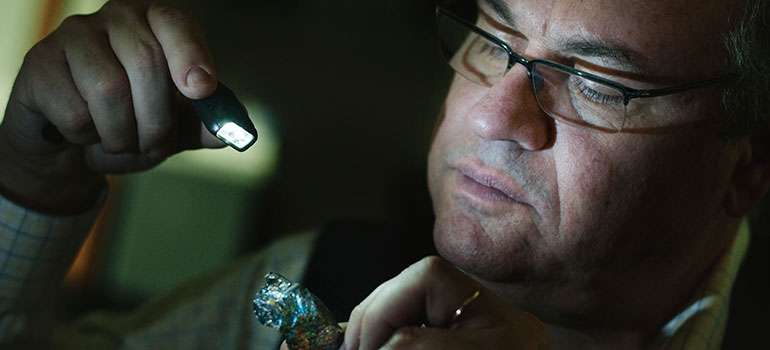Marcello Veiga. Credit: Martin Dee
Mention the Mad Hatter and the image that comes to mind is the character in Alice's Adventures in Wonderland—a little batty but quite harmless. But for UBC mining engineering professor Marcello Veiga, the words call up a darker image: mercury poisoning, particularly as it occurs among small-scale miners in developing countries.
Small-scale or artisanal mining is responsible for producing around 400 tonnes of gold a year worldwide. It supports 160 million people, including about 16 million who are directly involved in mining. But because most small-scale miners rely on mercury to extract gold (big mining companies no longer use mercury), the waste runoffs from the mines end up polluting the air and nearby waterways.
Artisanal gold mining is the second largest source of mercury pollution after the burning of fossil fuels, releasing around 1,400 tonnes of mercury to the environment every year, according to United Nations data. Over time, mercury absorbed by the body causes irreversible neurological damage such as tremors and loss of coordination, speech impairment, impaired vision and muscle weakness.
"Mercury has long been known to be a neurotoxin, causing damage to adults and birth defects in unborn children," said Veiga, who has studied gold mining in more than 40 countries. "In the Victorian era, mad hatter disease or hatters' shakes was common among English hat makers, because they used mercury to treat fur to make hats."
That's why for Veiga, who heads the research group Canadian Artisanal Mining Innovation (CAMI) at UBC, it's important to educate miners on alternative methods.
In 2009, Veiga started to study mercury air pollution in Antioquia, northwest Colombia, a well-known small-scale gold mining centre. The results of his research formed the core of an initiative to train local miners on cleaner mining technologies. The following year, UBC and the U.S. Department of State established a demonstration plant in Portovelo, Ecuador to train small miners and processors on better mining and processing methods.
By 2013, mercury levels in Antioquia were 50 to 60 per cent lower than in 2010.
"Miners learned that they can use much less mercury and increase gold recovery using technologies like gravity concentration, flotation and cyanidation," said Veiga. "They were taught how to fabricate equipment that can reduce their mercury exposure by as much as 95 per cent."
The miners also studied specific mining operations and realized that their very basic processes were highly inefficient at recovering gold from complex ores, said Veiga. By selling to ore buyers, they actually had more money in their pockets at the end of the day than if they had processed the ores.
The miners—and there are more than 200 miners from Colombia, Peru and Ecuador who have taken the training to date—are also encouraged to band together to form clean mining operations, something that Veiga believes will make clean mining more sustainable in the long term.
Over the next few years, Veiga's goal is to reach more gold mining communities. CAMI is setting up more training centres—four in Colombia and one each in Indonesia, Guyana, Peru and Honduras. Veiga is also actively working to get Canada to ratify the Minamata Convention on Mercury, a global treaty to decrease the levels of mercury entering the environment from human sources.
"We need to reduce the amount of mercury in circulation," said Veiga. "All the mercury-producing countries, including Canada, should not trade in mercury. Whatever you produce, you should remove from circulation."
Provided by University of British Columbia




















